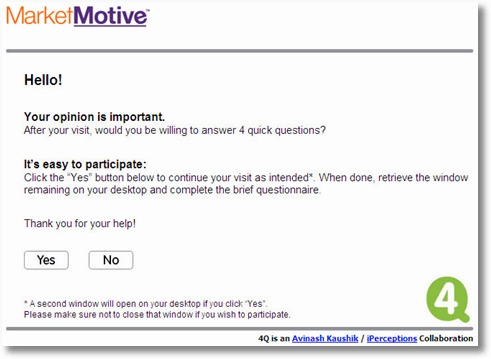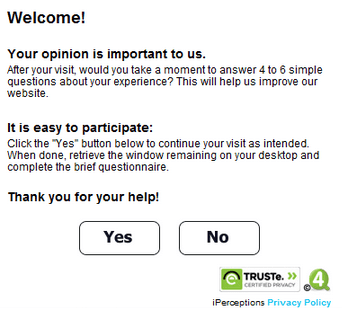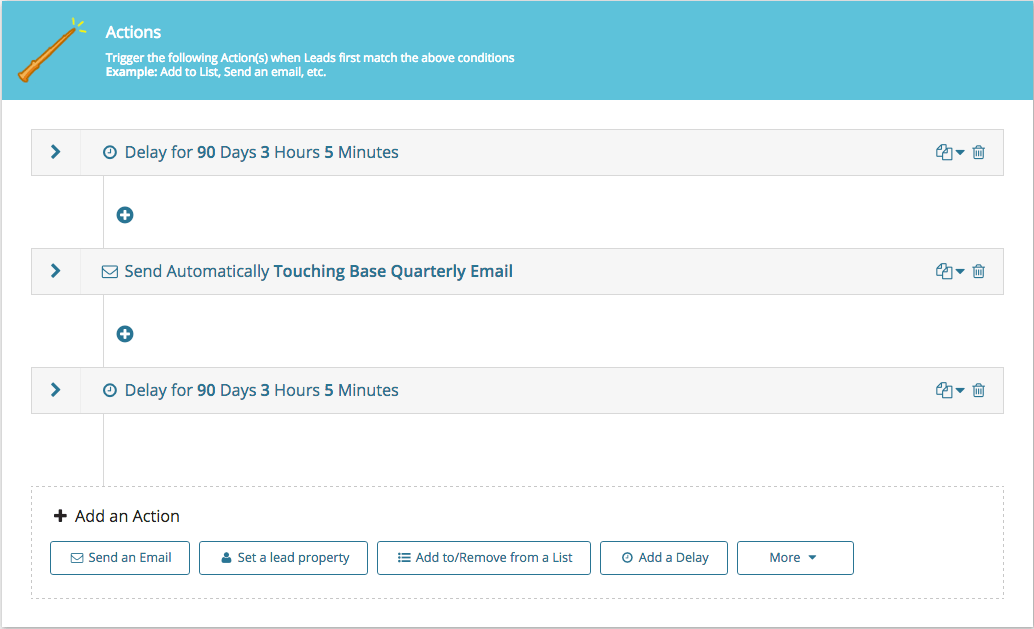How to boost your conversion rate without changing your web content
How do you improve your conversion rates without any changes to your web content? Columnist Jeremy Smith reveals seven strategies.

But there’s a difference between inelegantly grasping for sales versus adroitly funneling massive numbers of customers through the checkout process.
You don’t want to look desperate, sound desperate or do desperate. Desperation kills conversions.
So what do you do? As a marketer, you’re trying to improve those slouching conversion rates, but your hands are tied. Maybe your budget is gone. Maybe the quarter is winding down. There are quotas to be met, bosses to be pleased and improvements to be made.
Traditional conversion optimization provides the solution — hypothesize a website improvement, split test the change and pick the winner.
Many of these improvements, however, require substantial changes to content — bigger images, sizzling hot headlines, sharper CTA (call-to-action) text, longer copy, a more persuasive “About” page and so on.
What if you want to improve your conversion rates without changing your web content?
There are ways — smart, tactical methods that you can implement today.
In this article, I’ll provide seven methods for improving your conversion rate without changing the content on your website.
1. Use heat mapping.
Heat mapping is a method of website scanning that provides a visual depiction of how a website is gaining and converting organic traffic.
Heat maps are used for everything from global lighting standards to in-store shopping patterns.
You can even develop heat map tests of a Google Analytics report, indicating optimal conversion rate times.

Source: Harbor Island Analytics
You can see an hour-by-hour depiction of onsite engagement. Because it’s visual, even a layman can interpret the chart. Dubbed analytics 2.0 for websites, heat mapping is a unique approach to understanding data.
Heat mapping puts micro-level changes in perspective, and the quality of data it gathers is better than the quality of data hollowed out by conventional analytics tools. Heat maps can tell you where visitors did and didn’t click, as well as the optimal placement for banner ads and CTA buttons.
In short, heat mapping gives you access to bite-sized clusters of data that are critical to your site’s conversion rate.
Jaan M Sonberg of ConversionXL listed 19 findings revealed by a series of heat map tests. The first is how content placement can bring about a change in retention rate. Though it seems trivial, such an observation elucidates the importance of content placement for traffic conversion.
You’re probably familiar with eye-tracking heat map studies, which provide a visual outlay of where people look. A series of eye-tracking tests revealed that when a visitor’s eyes skim through website content, they move in the shape of an F.
The type of heat mapping tools available online don’t require eye scanners and sophisticated equipment. Instead, they track clicks on the page.
Click-monitoring tools can provide raw click data, which is informative on its own.

Source: Econda.com
But let’s say you want to better understand how different user segments are interacting with different products on an ecommerce page. What if you could figure out exactly where women are clicking vs. where men are clicking on a page?
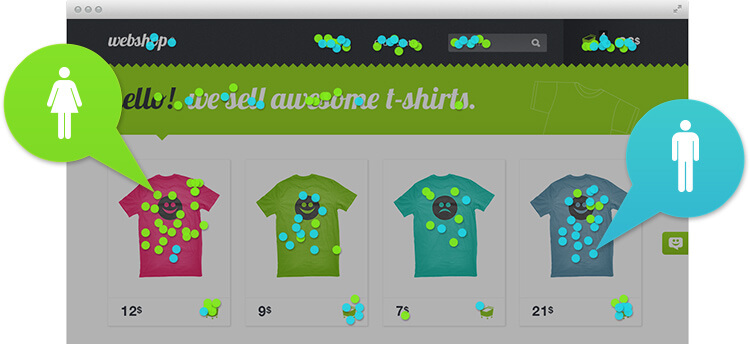
Source: UserReport
Basically, heat mapping delivers insights about how site visitors wade through the pages and how their eyes move. Analyzing these findings allows you to figure out how to optimize site navigation and increase your conversion rate.
I can’t prescribe the exact methods you should use to improve conversions based on click data. It varies according to your own heat map reports, the level of segmentation and the layout of your page.
Here are some things I’ve done as a result of analyzing heat maps:
- Removed buttons, content blocks and images.
- Placed items below the fold.
- Removed entire header menus.
- Adjusted navigation paths.
- Shortened funnels.
- Completely eliminated product display blocks.
- Removed carousels.
- Removed background images.
Much of my heat map data has compelled me to strip down, simplify and remove elements. Obviously, every improvement should be hypothesized, split-tested and analyzed. But it’s important to start with the data — understanding what’s going on, how users are interacting with the site and what kind of optimization is possible.
2. Conduct feedback surveys.
For B2C sites, an exit survey is helpful. Exit surveys ask customers who have made a purchase to fill out a questionnaire before they leave the site.
The B2B sales process is entirely different. The ideal time to survey B2B customers is when they are active on the site.
Marketers who are in favor of exit surveys reject this idea. According to them, a questionnaire that suddenly pops up may be considered intrusive, negatively impacting the conversion rate.
Let’s be honest, though. People who want to fill out the survey will do so. Those who don’t want to fill out the survey won’t. It’s that simple.
Sometimes, you can encourage action by telling people exactly how long the survey will take. Here’s a one-second survey.
Telling me that it’s going to take me one second makes me far more likely to click one of the four buttons and complete the survey.
As long as you’re polite about it, you’ll probably get some feedback. Here is an example in which the business asks you to “answer 4 quick questions.”
(That survey comes from Avinash Kaushik, co-founder of MarketMotive and one of our own. In the conversion optimization world, he knows what’s up.)
Here’s yet another example:
However, we can put pop-ups and unwanted exit surveys aside entirely and still conduct a B2B survey.
Here’s how:
- Use a rating scale. Ratings from 1 to 5, in ascending order, allow customers to express their satisfaction or dissatisfaction.
- Ask yes or no questions. B2B customers are often busy and distracted. They prefer simple yes/no feedback options.
- Conduct a micro-survey. The top or bottom right navigation pane is ideal for displaying micro-survey questions.
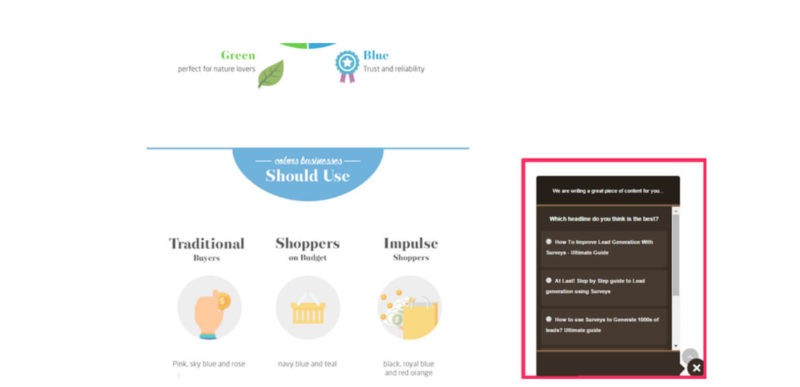
Source: TruConversion
As you can see, 80 percent of the page is clearly visible, and the micro-survey questions are not intrusive. If, instead of the bottom right, we put the questionnaire in the top right area, it needs to be unaffected by scrolling.
Feedback surveys can pinpoint conversion bottlenecks and satisfy customers. A software company surveyed their clients (all B2B), then collected and followed their recommendations. The result was a whopping 30-percent increase in their conversion rate.
Here’s the big takeaway: Give surveys a chance. They give you information, and information — properly understood and applied — is the elixir of life for conversion optimization.
3. Remove the doorways.
Many marketers don’t take doorways seriously enough, despite warnings from Google. In my opinion, doorways are conversion mirages because their purpose is to increase the lead count. In reality, they do more harm than good.
Doorway pages are especially common in the ecommerce world and are often mistakenly perceived to be a twofer — gaining both more traffic and conversions.
Truth be told, doorway pages slay both.
Let’s back up for a minute and make sure we understand what doorway pages are. Here’s an illustrated example from eMarketing Blogger:
And here’s Google’s definition, bereft of clip art:
[blockquote]Doorways are sites or pages created to rank highly for specific search queries. They are bad for users because they can lead to multiple similar pages in user search results, where each result ends up taking the user to essentially the same destination. They can also lead users to intermediate pages that are not as useful as the final destination.[/blockquote]
Google provides a list of questions to help you determine whether you’re using doorway pages:
- Is the purpose to optimize for search engines and funnel visitors into the actual usable or relevant portion of your site, or are they an integral part of your site’s user experience?
- Are the pages intended to rank on generic terms, yet the content presented on the page is very specific?
- Do the pages duplicate useful aggregations of items (locations, products and so on) that already exist on the site for the purpose of capturing more search traffic?
- Are these pages made solely for drawing affiliate traffic and sending users along without creating unique value in content or functionality?
- Do these pages exist as an “island?” Are they difficult or impossible to navigate to from other parts of your site? Are links to such pages from other pages within the site or network of sites created just for search engines?
And, while we’re on the subject of Google, it’s worth mentioning this: They hate doorway pages like they hate all things spam.
That’s why they’re always upgrading their opposition to doorway pages.
Let’s get back to no-content-change conversion improvements:
How can doorways gag your conversion rate, and how can removing doorway pages improve your conversion rate?
Doorways bring low-value search footprints to the site. Google’s Brian White said, “We’ve seen sites try to maximize their ‘search footprint’ without adding clear, unique value.”
It’s all about the value, folks.
Doorways hurt your conversion rate in two ways:
- They invite penalty from Google. Once penalized, a site faces difficulties attracting visitors, let alone converting them into leads.
- They bring untargeted visitors. These visitors won’t become customers.
Removing doorways helps you achieve value-added search footprints. You are not making changes to your site content. You are simply deleting a few pages to keep the site simple and uncluttered.
It’s easy to identify the doorways. In his article on Search Engine Land, Andrew Shotland identified empty pages and hard-to-find pages as doorways, and he advised marketers to steer their sites clear of such pages.
An easier method is to check the intention behind creating a page. (Remember value?) If the intention is to get visitors from search engines and push them deeper into the sales funnel without any semantic resemblance between the site content and the keywords used to conduct the search, then the page is definitely a doorway.
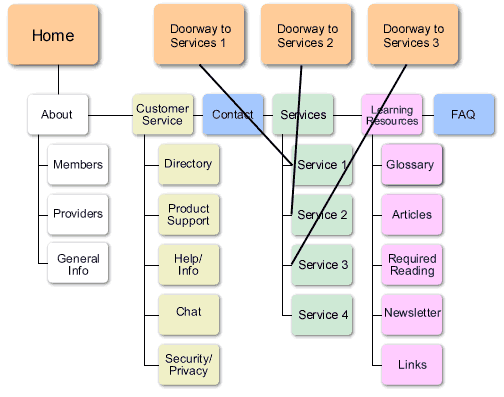
Source: SEO Logic
Such pages are a poor ripoff of the all-important sales funnel. Unlike an optimized sales funnel, which takes visitors through its layers, doorways lack an informational hierarchy and are used only to bring site visitors closer to CTA buttons.
Removing the doorways makes your site neat and ensures that search footprints are high-valued, meaning they are targeted and likely to convert customers.
4. Encourage user-generated content.
User-generated content is an old method with plenty of new iterations for the modern marketer.
B2C brands are the ones that leverage it the most. For example, Bass Pro Shop implemented UGC improvements to their website and scored 59 percent higher conversion rates.
User-generated content can benefit B2Bs as well.
The B2B customer pool is usually more nichefied than B2C sites. Customers often have networking ties with each other. If one customer generates favorable content in support of a vendor, others will take it seriously.
I know what you’re thinking: This isn’t how the B2B industry works. Customer testimonials are important to an extent, but user-generated content marketing is too much. B2B is all about conference calls, brainstorming sessions and sales pitches couched with specialized language, right?
Wrong.
A study done by SAP Hybris and Accenture Digital shows B2B customers look forward to the same level of personalization that their B2C counterparts expect.
Take a look at the infographic.
Content generated by existing or previous customers indicates personalization and reflects personalized experiences. Note: The content is not generated by you but by someone else, which means your involvement is nonexistent. From your end, you are not changing the content on your site. A B2B customer can interpret this as an indicator of authenticity. It’s a win-win situation.
Integrating UGC into the site can escalate the conversion rate.
The above infographic from RJMetrics shows the conversion rate is high when UGC is onsite. Ad value is irrelevant for an organic B2B campaign.
Engagement, as we’ve seen, is important, but conversion is clearly the priority, and UGC sparks an increase in conversion rates.
5. Start an email drip campaign.
For B2B marketing, an email drip campaign is a major win.
Customers are sent emails based on the actions they perform on the site. A drip campaign is often called an automated campaign because emails are collected and sent from a prewritten set, eliminating the need to manually compose each one.
Salespeople know how difficult it is to convert leads into sales. A drip email campaign can lend a hand by creating a lead net, which can close the gaps that leads so often seep through.
A drip campaign lets you do the following:
- Welcome anyone who signs up for an account for the first time.
- Suggest content that has the power to convert.
- Recommend products and services based on customers’ preferences.
- Explain to existing free account holders why it’s essential for them to shift to a premium account.
Lead generation alone is not enough. Lead nurturing is equally important. All the actions listed above are essential for nurturing leads.
In a B2B drip campaign case study, XOsoft, a software service provider, used a drip marketing campaign and converted 60 percent of their qualified leads. The prewritten emails were sent quarterly.
Below, you can see their email automation dashboard.
The dashboard allows you to add delay time and set lead properties. In this example, the delay time is three months.
Now, check out the image below.

Source: Wishpond
If a lead replies positively, he’ll be directed to the 14-day trial version download page. If the reply is negative, then the lead will be “kept warm.”
The reason 79 percent of qualified leads fail to convert is that they aren’t nurtured using drip email campaigns. Drip marketing can increase the email open rate to 80 percent, and the CTR is three times higher than the typical email marketing CTR.
A drip email campaign is a surefire way to increase your conversion rates without making any changes to your web content.
6. Use multi-screen marketing.
There is a link between multi-screen marketing and conversion rate. Google noticed this link back in 2013 and introduced a feature called Estimated Total Conversions. The feature was described as “an exciting first step to give marketers more insight into how AdWords drives conversions… that take multiple devices to complete.”
The benefits of multi-screen marketing? Oh, just greater reach, improved customization, enhanced efficiency and higher relevance.

Source: Chirpify
That’s all.
In other words, just the kinds of things that make conversion rates go through the roof.
Multi-screen advertising begets cross-device conversion. Google gave an excellent example of this in their blog. Cross-device conversion adds up to the cumulative conversion rate. Multi-screen marketing also offers key information related to consumer behavior.
This infographic shows that internet browsing is the most common activity (81 percent) among cross-device users. Brands can reach out to consumers through internet ads instead of spending money on expensive television ads.
Nothing is more damaging in a multi-screen world than a device-agnostic approach. The desktop and the mobile web differ in almost every area. Marketers acknowledge that and aim to create a unique layout (with the help of responsive design) for all devices.
Multi-screen campaign success articulates the importance of device-specific identities. And what kinds of devices are most important in the multi-screen world?
You guessed it.
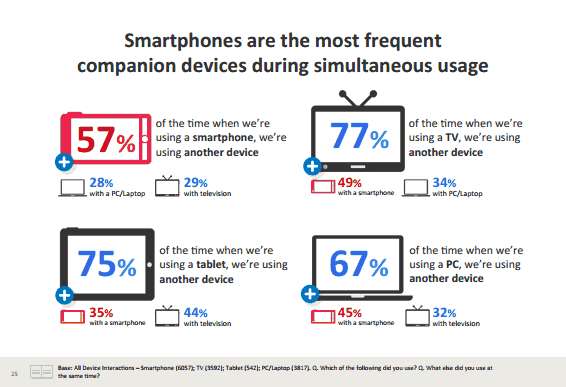
Source: MediaVision
Small brands often use multimedia content to engage with prospective leads. They target the handheld user base. In 2014, 61 percent of B2B customers downloaded work-related videos on their smartphones. This shows that B2B is as nuanced in terms of device usage as B2C.
Through multi-screen marketing, B2B vendors can put their fingers on multiple customer segments, separated from each other in terms of device usage. Along with improving their visibility, they can retrieve actionable insights, both of which are essential for a surge in conversion rates.
7. Shorten loading time.
A slow-loading site will murder your conversion rates.
Fixing the loading time should be the priority for a B2B marketer. The fact that the B2B vertical cannot properly track the impact of loading time delay is worrisome.
B2C businesses, especially online shops, know how a delay in loading time can hinder their sales. According to TruConversion, ecommerce sites making $3 million a month can lose up to $2.5 million a year if there’s a delay of just one second.

Source: GlobalDots
The image above shows that sites offering products or services, regardless of whether they are B2B or B2C, are affected by slow loading time. Even a one-second delay causes a seven-percent drop in conversion.
Shortening your website’s loading time should be your priority if you want to see your conversion rate climb.
The great thing about most speed improvements is that they cost little, happen quickly and require no content changes. Most of the time, it’s a simple issue of implementing a CDN, tweaking some cache settings and rearranging some scripts.
The result? Instant conversion rate lifts.
Conclusion
The seven strategies discussed in this article will give you conversion improvements.
You’ll see your conversion rate increase and your sales figures perk up, all without any changes to your web content.
Expecting results overnight can throw a wrench into your efforts. Follow these tips, be patient, and I guarantee you’ll see a boost in your overall digital marketing, and specifically in your site’s conversion rate.
Contributing authors are invited to create content for MarTech and are chosen for their expertise and contribution to the martech community. Our contributors work under the oversight of the editorial staff and contributions are checked for quality and relevance to our readers. The opinions they express are their own.
Related stories

